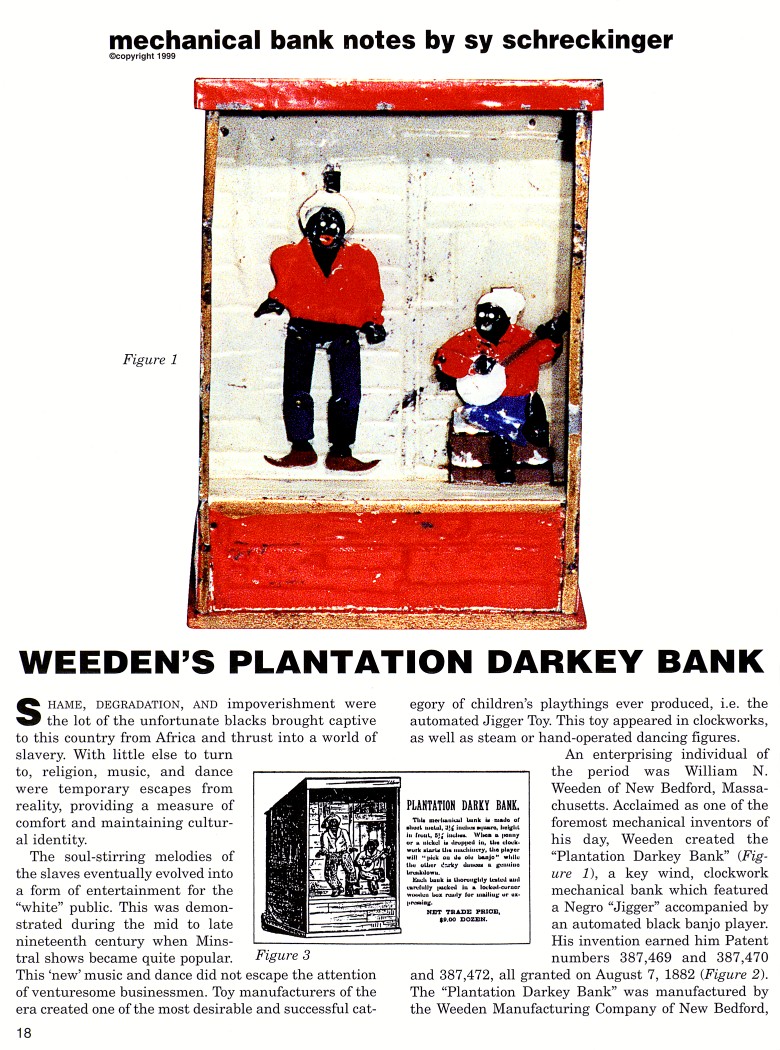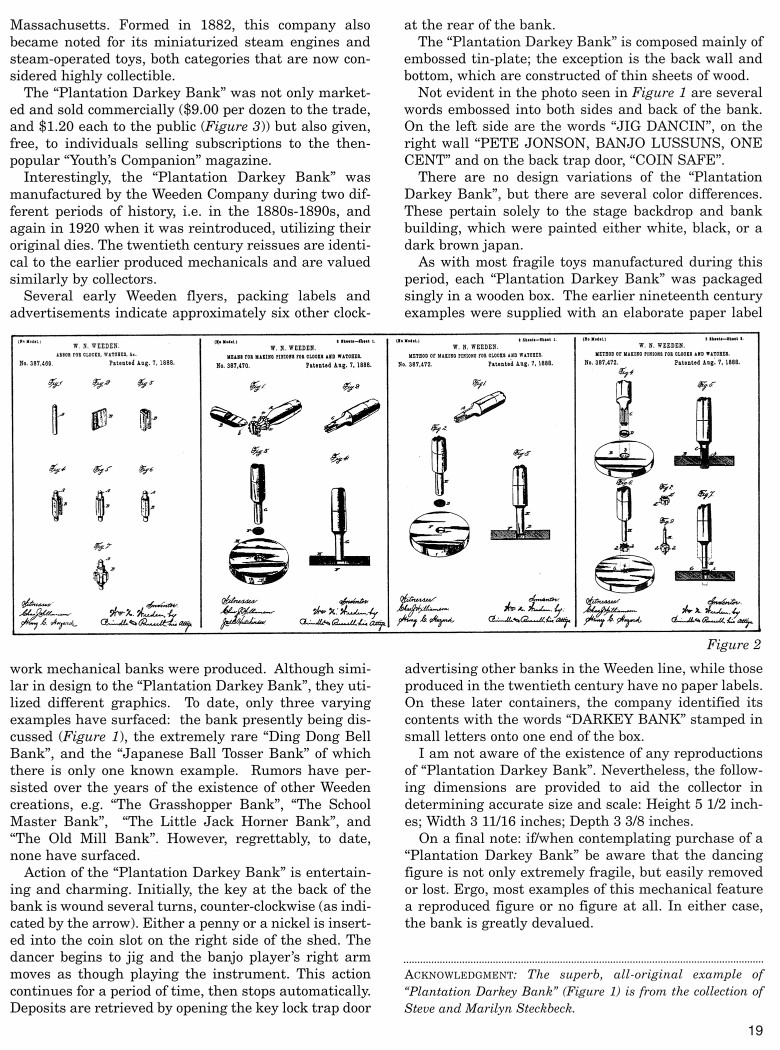|
Weeden’s Plantation
Darkey Bank
by Sy Schreckinger – ANTIQUE TOY WORLD Magazine – December,
1999
Shame, Degradation, and impoverishment were the
lot of the unfortunate blacks brought captive to this country from Africa
and thrust into a world of slavery. With little else to turn to, religion,
music, and dance were temporary escapes from reality, providing a measure
of comfort and maintaining cultural identity.
The soul-stirring melodies of the slaves eventually evolved into a
form of entertainment for the "white" public. This was demonstrated during
the mid to late nineteenth century when Minstral shows became quite
popular. This 'new' music and dance did not escape the attention of
venturesome businessmen. Toy manufacturers of the era created one of the
most desirable and successful category of children's playthings ever
produced, i.e. the automated Jigger Toy. This toy appeared in clockworks,
as well as steam or hand-operated dancing figures.
An enterprising individual of the period was William N. Weeden of New
Bedford, Massachusetts. Acclaimed as one of the foremost mechanical
inventors of his day, Weeden created the "Plantation Darkey Bank" (Figure
1), a key wind, clockwork mechanical bank which featured a Negro "Jigger"
accompanied by an automated black banjo player. His invention earned him
Patent numbers
387,469 and
387,470 and
387,472, all granted on August 7,
1882 (Figure 2). The "Plantation Darkey Bank" was manufactured by the
Weeden Manufacturing Company of New Bedford, Massachusetts. Formed in
1882, this company also became noted for its miniaturized steam engines
and steam-operated toys, both categories that are now considered highly
collectible.
The "Plantation Darkey Bank" was not only marketed and sold
commercially ($9.00 per dozen to the trade, and $1.20 each to the public
(Figure 3)) but also given, free, to individuals selling subscriptions to
the then- popular "Youth's Companion" magazine.
Interestingly, the "Plantation Darkey Bank" was manufactured by the
Weeden Company during two different periods of history, i.e. in the
1880s-1890s, and again in 1920 when it was reintroduced, utilizing their
original dies. The twentieth century reissues are identical to the earlier
produced mechanicals and are valued similarly by collectors.
Several early Weeden flyers, packing labels and advertisements
indicate approximately six other clock work mechanical banks were
produced. Although similar in design to the "Plantation Darkey Bank", they
utilized different graphics. To date, only three varying examples have
surfaced: the bank presently being discussed (Figure 1), the extremely
rare "Ding Dong Bell Bank", and the "Japanese Ball Tosser Bank" of which
there is only one known example. Rumors have persisted over the years of
the existence of other Weeden creations, e.g. "The Grasshopper Bank", "The
School Master Bank", "The Little Jack Homer Bank", and "The Old Mill
Bank". However, regrettably, to date, none have surfaced.
Action of the "Plantation Darkey Bank" is entertaining and charming.
Initially, the key at the back of the bank is wound several turns,
counter-clockwise (as indicated by the arrow). Either a penny or a nickel
is inserted into the coin slot on the right side of the shed. The dancer
begins to jig and the banjo player's right arm moves as though playing the
instrument. This action continues for a period of time, then stops
automatically. Deposits are retrieved by opening the key lock trap door at
the rear of the bank.
The "Plantation Darkey Bank" is composed mainly of embossed
tin-plate; the exception is the back wall and bottom, which are
constructed of thin sheets of wood.
Not evident in the photo seen in Figure 1 are several words embossed
into both sides and back of the bank. On the left side are the words "JIG
DANCIN", on the right wall "PETE JONSON, BANJO LUSSUNS, ONE CENT" and on
the back trap door, "COIN SAFE". There are no design variations of the
"Plantation Darkey Bank", but there are several color differences. These
pertain solely to the stage backdrop and bank building, which were painted
either white, black, or a dark brown japan.
As with most fragile toys manufactured during this period, each
"Plantation Darkey Bank" was packaged singly in a wooden box. The earlier
nineteenth century examples were supplied with an elaborate paper label
advertising other banks in the Weeden line, while those produced in the
twentieth century have no paper labels. On these later containers, the
company identified its contents with the words "DARKEY BANK" stamped in
small letters onto one end of the box.
I am not aware of the existence of any reproductions of "Plantation
Darkey Bank". Nevertheless, the following dimensions are provided to aid
the collector in determining accurate size and scale: Height 5-1/2 inches;
Width 3-11/16 inches; Depth 3-3/8 inches.
On a final note: if/when contemplating purchase of a "Plantation
Darkey Bank" be aware that the dancing figure is not only extremely
fragile, but easily removed or lost. Ergo, most examples of this
mechanical feature a reproduced figure or no figure at all. In either
case, the bank is greatly devalued.
ACKNOWLEDGMENT: The superb, all-original example of "Plantation
Darkey Bank" (Figure 1) is from the collection of Steve and Marilyn
Steckbeck.
|


